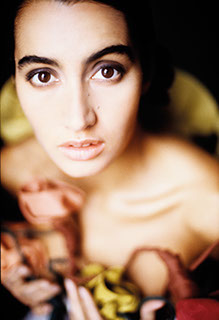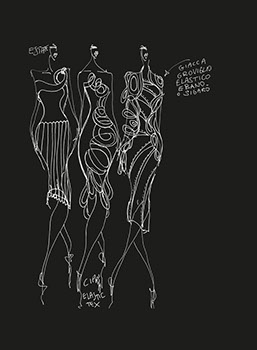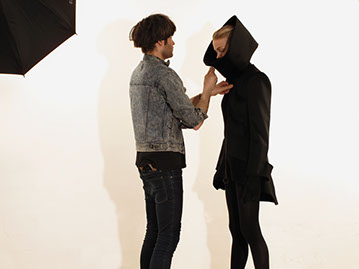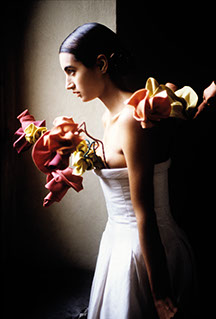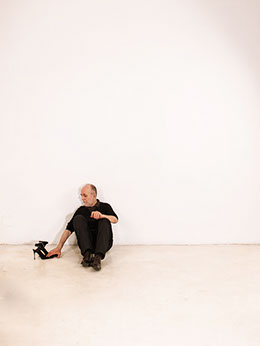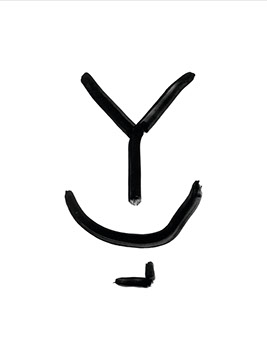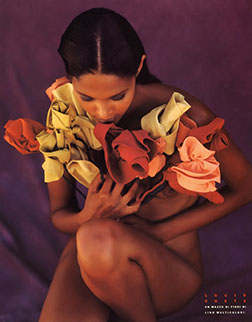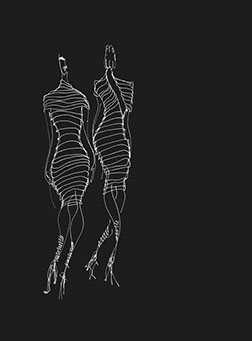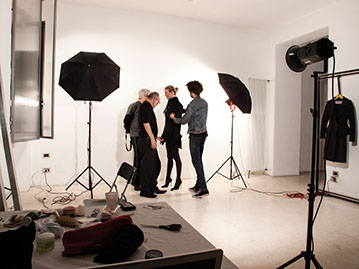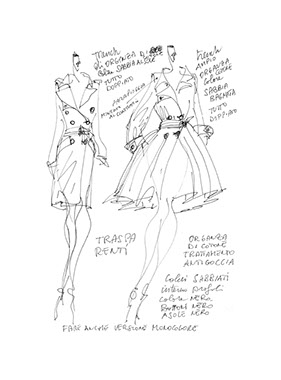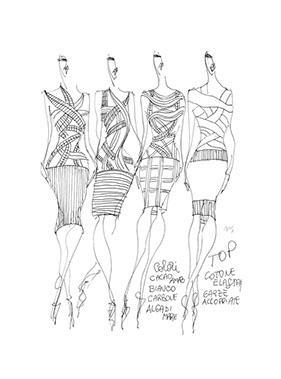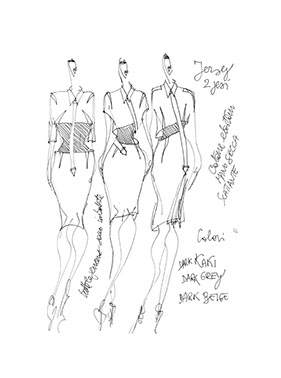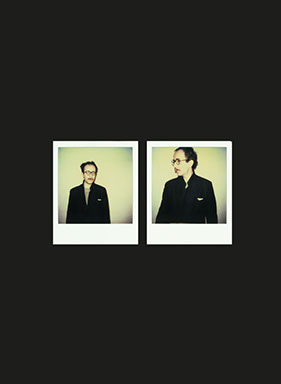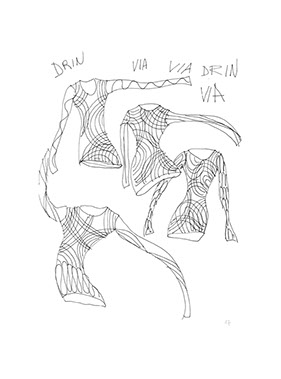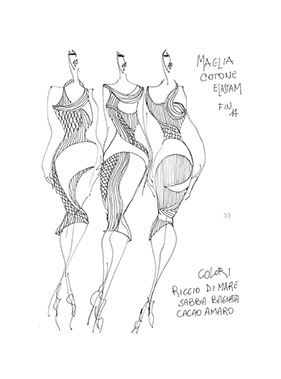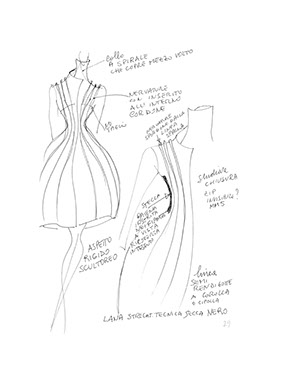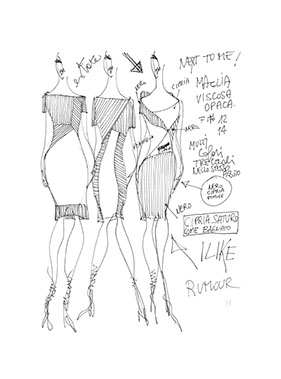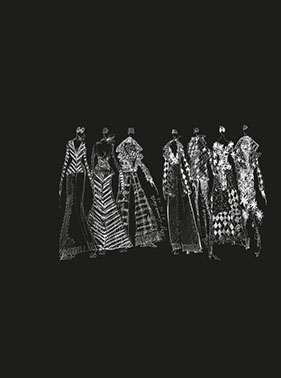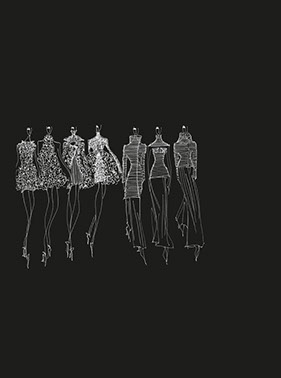
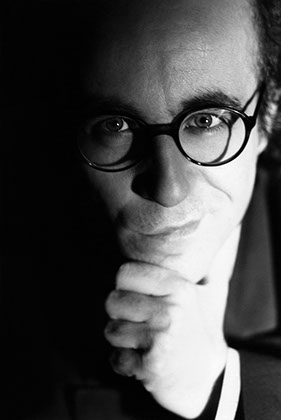
UNFORGETTABLE LUCIO
Lucio Costa was born in Vicenza, Italy, in September, 1951, where he lived
until he was eight years old and moved to Milan with his family.
From childhood he displayed a natural tendency for drawing and his mother,
Head Saleswoman and creative window-dresser for the post-war Vicenza’s Standa department store, besides educating his compositional taste and his eye for color,
was the basic inspiration in the formation of his stylistic personality with its particularly elegant and subtle tone.
Costa spent his adolescence painting, encouraged by parents who brought him
into close contact with exhibitions and books on art. He went to Brera Artistic Liceo.
This artistic formation developed a strong aesthetic sense and taught him to pursue
assiduous creative research – a trait which was strengthened further when he went
on to study at the Milan Scuola del Cinema, specializing in Scenography and Costumes. He had his first work experience as an Assistant Scenographer and,
at the same time, to round out the meager pay, he worked briefly as a salesman
in the Boggi store in Piazza San Babila, coming into contact with the world of fashion at a moment which found it unusually open.
Indeed, he was quickly given responsibility for Carrano’s accessory boutique
in via della Spiga: a post which put him directly into the luxury ready-to-wear world
in full expansion – and intocontact with the well-known Milanese showroom
Manzoni 20, concessioners of the men’s and the women’s collections of Tierry Mugler
and Claude Montana ( and where he met Umberto Ginocchietti, owner of the Maglificio di Perugia, who drew him into his own firm as Fashion Coordinator for Christian Dior’s commercial line ).
Read more...
This experience confirmed Style as the expressive area he felt to be most his own, fixing his future professional pathAfter his experience with the Maglificio di Perugia, Lucio Costa began to work as a Fashion Designer in the La Perla Group and, subsequently, collaborated with important beachwear, knitwear and ready to wear brands. Among the most significant collaborations are those of the early 1980s with Loretta Di Lorenzo’s first Women’s Line and for Fenzi’s men’s and women’s knitwear. These were followed by Mariella Burani’s Beach and Yachting collection and, more recently, Jean Charles De Castelbajac’s collection for women.
In the early 1990s, Lucio Costa was also the stylist of reference for the Linea Basile 28 Donna Giappone, and ready to wear consultant for the Japanese market.
The Comitato Moda Industriali Tessili Abbigliamento and the specialized magazines
of the sector turned to Costa’s collaboration in determining the seasonal trends of the sector and, in his final years, he was called upon to bring his experience to the young as well, serving as academic Lecturer of Fashion Design. In 1987, along with these consultancies, Lucio Costa decided to create collections under his own brand and
set up a firm with Roberto Pelizzoni.
The first public presentation of the Lucio Costa Collection, centered on knitwear, debuted that same year on a runway in Milan’s central Teatro Litta. In this first show, Costa put all of his tendency to the dreamlike and the playful, presenting child models who moved across the stage playing and romping as they went.
The style of this first collection was part of the new direction emerging among
the stylists of the period who, from that moment, began to propose deconstructed garments with un-padded, “natural”, shoulders, totally at odds with the squared-off volumes dominating the early 1980s. From its first show, the Lucio Costa Collection was purchased by such trend-setting boutiques as Zeus in Milan, Ivo Milan in Rovigo, Antonioli and Dantone, Milan.
It represented in full Costa’s stylistic personality, in which the objective of exalting women and their femininity is expressed in the best Italian sartorial tradition, linked with contemporary design and research. The positive response of the internal market was followed by that of the international market, where the Lucio Costa brand was purchased by such luxury fashion multi-brand stores as Isetan in Tokyo, Villamoda
in Kuwait, and Henry Bendell in New York. Sales were especially wide-spread
in Japan where, in November, 1994, the Italian Institute for Foreign Trade promoted
a show of his Spring-Summer collection in Tokyo’s Takashimaya Department Store. The Lucio Costa Collection, produced on license by Gieffe of Ronco Briantino,
was presented until the Autumn-Winter Season, 2000-2001.
Lucio Costa’s originality and professionalism brought him a number of awards.
The first of these was the “Creativity Prize”, awarded him in 1990 by the Centro Tutela Lino at the “Contemporary” show dedicated to young stylists at the Milan Fair.
His clothes were on view in various events and exhibitions, from the Montecarlo Linen Festival and the Milan Triennale show dedicated to Fashion and Design, to Vogue Italia’s 1994 celebrations, where a group of photos of the Lucio Costa Collection were present. Opinion leaders and fellow professionals of the fashion world have shown
their appreciation of his style: among these the extraordinary fashion critic,
Anna Piaggi, who included Costa’s clothes in her famous Doppie Pagine.
Many magazines have published articles on his style and photographs of his clothes: some of these appear in the Press section of this volume; various televisions – Italian and international – have devoted space to interviews with him, bio-documentaries,
and views of his collections on the catwalk.
The official launch of the street wear brand LCY ( Lucio Costa Yarn ),
dates from the Spring-Summer of 2003. Initially made up of T-shirts, it evolved
with the Fall-Winter, 2006-2007 season, into a total look in men’s and women’s knitwear, in which Costa gave full expression to his experience with
- and sensitivity for - knitwear. The success of the brand – whose garments were initially made by the Confezioni Victory in Limito di Pioltello and, subsequently, by the Styltricot in Cernusco – was immediate. The T-shirts, which stand out for a graphic impact that is highly characteristic and decisive, are immediately convincing in the tone and content of the messages they express. From its very first season, the LCY brand was on sale in some thir ty of the most prestigious luxury fashion multi-brand Italian shops. In the following phases of this knitwear, traditional and special quality yarns were manipulated and treated in innovative ways, from their fulling to their final phase and mixed with the most innovative and alternative techniques of digital printing
and modes of garment making.
Covers Lucio Costa is the last brand Costa created, made up of Micro Capsule Collections of high level, limited edition, specials. The first Capsule, comprising
only outer wear for women, was presented in the Fall Winter Season of 2008 - 2009; the last, complete with garments and accessories, was presented in the Fall Winter Season of 2011 - 2012. Lucio Costa’s Covers, real cult pieces – icons for magazine covers, characterized by an international “image” and appeal - have been highly considered by Italian retailers, registering the return of historic top clients like Daad
in Milan, as well as new leaders like Penelope in Brescia and Fiacchini in Forte
dei Marmi. The handbag Capsule was made on license by Orus of Mortara;
the garments and the outerwear by Apoptygma of Vigevano. With Covers,
Costa wholly recovered possession of his stylistic identity and the creative DNA
of his first, historic, Lucio Costa line.
SO LUCIO!
THE BIOGRAPHICAL BOOK DEDICATED TO LUCIO COSTA
